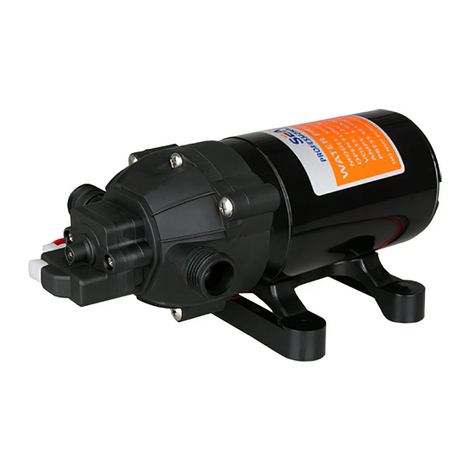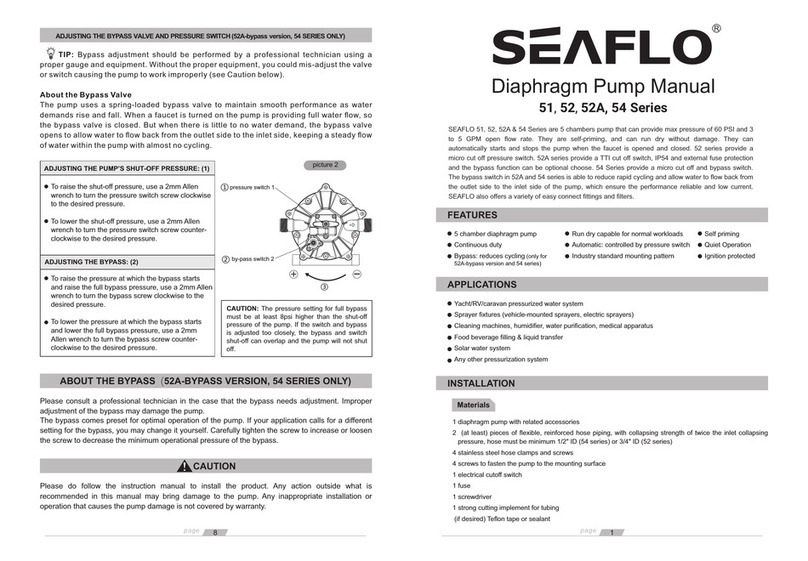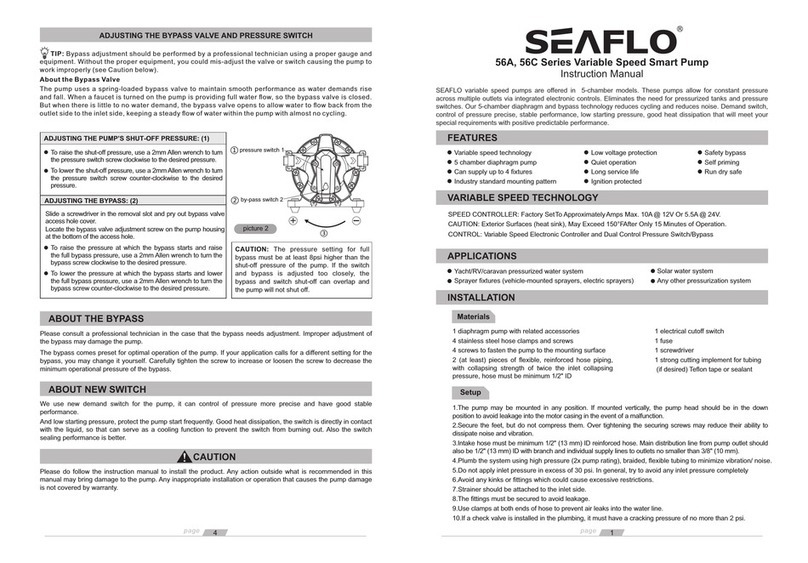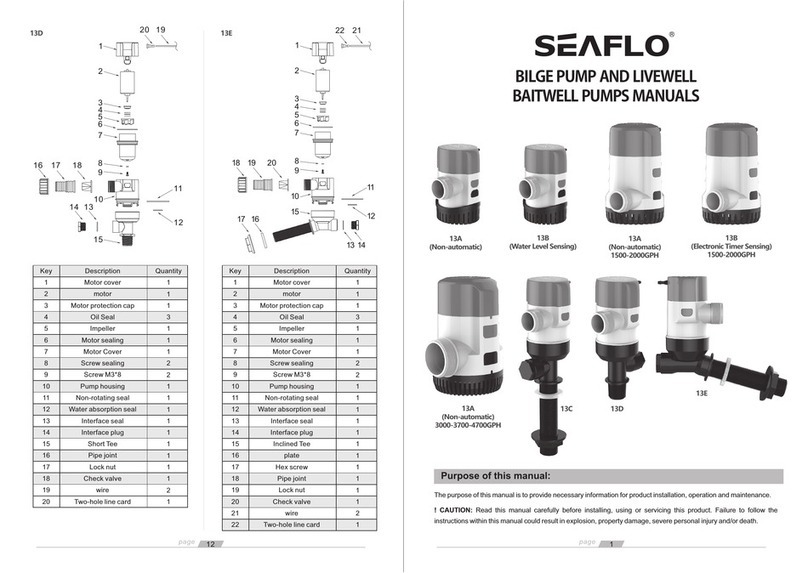
2
page
1
page
FEATURES
5 chamber diaphragm pump
Continuous duty
Industry standard mounting pattern
Run dry capable for normal workloads
Automatic: controlled by pressure switch
Bypass: reduces cycling(only for 54series)
APPLICATIONS
INSTALLATION
Self priming
Quiet Operation
Ignition protected
Yacht/RV/caravan pressurized water system
Sprayer fixtures (vehicle-mounted sprayers, electric sprayers)
Cleaning machines, humidifier, water purification, medical apparatus
Food beverage filling & liquid transfer
Solar water system
Any other pressurization system
Materials
1 diaphragm pump with related accessories
2 (at least) pieces of flexible, reinforced hose piping, with collapsing strength of twice the inlet collapsing
pressure, hose must be minimum 1/2" ID (51 & 54 series) or 3/4" ID (52 series)
4 stainless steel hose clamps and screws
4 screws to fasten the pump to the mounting surface
1 electrical cutoff switch
1 fuse
1 screwdriver
1 strong cutting implement for tubing
(if desired) Teflon tape or sealant
Setup
1.The pump may be mounted in any position. If mounted vertically, the pump head should be in the down
position to avoid leakage into the motor casing in the event of a malfunction.
2.Secure the feet, but do not compress them. Overtightening the securing screws may reduce their ability to
dissipate noise and vibration.
3.Intake hose must be minimum 1/2" (13 mm) ID (51 & 54 series) or 3/4" (19 mm) ID (52 series) reinforced
hose. Main distribution line from pump outlet should also be 1/2" (13 mm) ID (51 & 54 series) or 3/4" (19
mm) ID (52 series) with branch and individual supply lines to outlets no smaller than 3/8" (10 mm).
4.Plumb the system using high pressure (2x pump rating), braided, flexible tubing to minimize vibration/ noise.
5.Do not apply inlet pressure in excess of 30 psi. In general, try to avoid any inlet pressure completely.
6.Avoid any kinks or fittings which could cause excessive restrictions.
7.Strainer should be attached to the inlet side.
8.The fittings must be secured to avoid leakage.
9.Use clamps at both ends of hose to prevent air leaks into the water line.
10.If a check valve is installed in the plumbing, it must have a cracking pressure of no more than 2 psi.
11.If applying a sealer or plumbing tape, be careful to not overtighten, as they may be sucked into pump.
12.This pump should be wired on its own dedicated circuit. Connect the positive lead (red) to the positive
terminal of your battery and the negative wire (black) to the negative terminal of your battery.
13.In an easily accessible location, install a switch to control electricity to the pump. Turn the pump off when
not used for extended periods or when the tank is empty.
14.The electrical circuit should be protected with an over-current protection device (fuse) in the positive lead.
This pump requires a 40 amp fuse.
15.The pump circuit should not include any other electrical loads.
16.As the water supply pump is non-essential, reference the wire chart under the electrical information. Be
sure to have the correct wire sizing for the length of wire you are using.
17.After installation, check the voltage at the pump motor. Voltage should be checked when pump is operating.
Full voltage must be available at the pump motor at all times.
ELECTRICALINFORMATION
Notes
1.Flexible potable water hose or PEX tubing is recommended instead of rigid piping at pump. If you choose
to use rigid piping, provide a short length of hose between pipe and the pump to avoid noise and vibration.
2.SEALFO does not recommend the use of metal fittings. When possible, use the provided plastic fittings.
3.Do not adjust the bypass personally without the help of technician.
4.Lack of sanitizing and maintenance is one of the main reasons of under performance of the pump. Please
do maintenance and winterize the pump at appropriate times, especially before and after a period of storage.
Ft.(M)
0-20(0-6)
20-30(6-9)
30-50(9-15)
50-65(15-19)
AWG(MM²)
14 AWG
12 AWG
10 AWG
8 AWG































